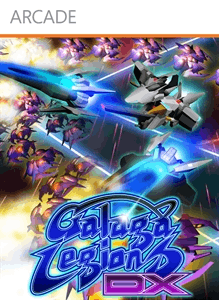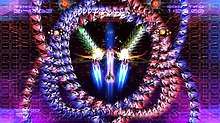Galaga Legions DX
Galaga Legions DX[lower-alpha 1] is a 2011 twin-stick shooter video game developed and published by Namco Bandai Games for the Xbox 360 and PlayStation 3. It is the sequel to Galaga Legions (2008), and is the fourteenth entry in the Galaxian series. The player controls the AEf-7 "Blowneedle" starship in its efforts to wipe out the Galaga forces before they destroy all of mankind. The objective is to clear each of the game's nine stages in the quickest time possible by destroy waves of enemies. The Blowneedle has a pair of satellites that can be pointed at enemies to shoot them down. New additions have been made to the core gameplay, such as a "slowdown" effect when the player is about to collide with an enemy.
| Galaga Legions DX | |
|---|---|
 Xbox 360 cover art | |
| Developer(s) | Namco Bandai Games |
| Publisher(s) | Namco Bandai Games |
| Director(s) | Tadashi Iguchi |
| Producer(s) | Toshihiko Tamura |
| Composer(s) | Akihiko Ishikawa |
| Series | Galaxian |
| Platform(s) | Xbox 360, PlayStation 3, Windows Phone |
| Release | |
| Genre(s) | Twin-stick shooter |
| Mode(s) | Single-player |
The game was developed by the same team behind Pac-Man Championship Edition DX, headed by director Tadashi Iguchi and producer Toshiko Tamura. Iguchi thought the original Legions tried too hard to be original and only appealed to a niche audience, deciding to make the game appeal towards more casual players with simple controls and a focus on frantic gameplay. The team focused heavily on high-score battles as a callback to video game tournaments from the early 1980s, and to appeal towards both veterans and newcomers to the Galaxian series. It was the second game released under the Namco Generations label, and was made to coincide with the 30th anniversary of the original Galaga arcade game.
Upon release, Galaga Legions DX was met with mostly favorable reviews from critics. Reviewers praised the game's graphics, frantic gameplay and improvements made over its predecessor, although would criticize its lack of content and for not being as well-refined as the first game. A Windows Phone version of the game was released in 2012. The Xbox 360 version was made available on the Xbox One in 2016 as part of the system's backwards compatibility lineup. It was the only other game released under the Namco Generations label, as it was discontinued a year after the game's release in 2012.
Gameplay

Galaga Legions DX is a twin-stick shooter video game and a sequel to Galaga Legions. Controlling a starship, the AEf-7 Blowneedle", the player is tasked with clearing each of the game's nine stages by clearing out enemy formations in the quickest time possible. Enemy paths are dictated by glowing neon lines, able to appear from the bottom, top and sides of the screen. Some enemies will explode and destroy anything around them when shot, which can used to create chain reactions. Shooting large "black hole bombs" carried by certain enemy formations will suck in all on-screen enemies into a vortex and become allies with the player, adding additional firepower.
Several changes were made to the core gameplay compared to the original game. The Blowneedle's pair of satellites return, although can no longer be detached and placed on select areas on the screen — instead, the satellites can be pointed towards enemies using the analog sticks to help clear them out, or be mirrored from each other to take down enemies coming from both directions. A "slowdown" effect is applied when the Blowneedle is about to collide with an enemy, giving the player a chance to escape before dying.
Each stage is made up of five "waves", each getting progressively more difficult as the game progresses. Each wave has a time limit based on how long it takes the player to clearing formations. Bonus points are awarded for clearing formations under a par time, which can affect the player's score at the end of the stage. The "Championship" mode from the original Galaga Legions makes a return, being a score-attack mode pitting the player against multiple enemy waves. Akin to Legions, several skin types can be selected that alter the visuals, some replacing the enemies with those from the original Galaga, Pac-Man, Mappy and Rally-X. High-score tournaments were held periodically, where players had to beat the scores of others from around the world.
Development
In 2008, Namco Bandai Games published Galaga Legions for the Xbox 360 and PlayStation 3. While the game was well-received by players and reviewers,[1] a common criticism was its drastic departure from the core gameplay of its predecessors.[1] While Galaxian and Galaga were fixed shooter arcade games, Galaga Legions was a twin-stick shooter often compared to Geometry Wars: Retro Evolved.[2][3] Tadashi Iguchi, the director of Legions, decided to create a sequel that made the game much more accessible for new players.[1]
After completing work on Pac-Man Championship Edition DX, Iguchi returned to direct Galaga Legions DX. Assisting him in production was a small team, with key members being producer Toshiko Tamura and Klonoa creator Hideo Yoshizawa.[1] Iguchi believed that one of the biggest weaknesses of the original Galaga Legions was that it was trying too hard to be original; as such, it had a relatively niche appeal.[4] For the sequel, he focused primarily on making the intuitive and welcoming for both newcomers and veterans for the series, wanting to find a nice balance between simplicity and complexity. His experience with Pac-Man Championship Edition DX, a well-received update to Pac-Man, helped provide a structure and basis for how Legions DX should be designed.[1] Simplicity was a major goal for the project, as the development team didn't want something too easy or a game that was too complex to the point of it being hard to understand.[4] Several aspects were simplified or slightly tweaked to reflect this; the level structure in particular was made to be non-linear, as Iguchi felt that linear level progression was not fun and wanted players to choose their own way to play the game.[4]
One of the biggest aspects of Legions DX during production was its heavy focus on scoring and competition. Iguchi believed that part of the reason shoot'em ups became popular in the first place was due to score tournaments, which he wanted to incorporate into Galaga Legions DX.[1] He felt that would ignite a competitive spirit within players, and drive them to compete against each other for scores.[1] Many mechanics in the game were modified to support this idea, with the removal of the linear level system being one of them. It was described as an "enemy curtain" shooter due to the way that massive enemy formations closed in on the player, similar to the movement of curtains.[5] The soundtrack was composed by Akihiko Ishikawa. The game was also made to celebrate the 30th anniversary of the original Galaga arcade game.[6]
Release
Galaga Legions DX was released for the Xbox 360 worldwide on June 29, 2011. The PlayStation 3 version was released on August 2, 2011 in North America, a day later on August 3 in Japan, and on August 10, 2011 in Europe. A version for Windows Phone was released on September 4, 2012.[7] The Xbox 360 version was added to the Xbox One backwards compatibility lineup on April 27, 2016.[8]
Reception
| Reception | ||||||||||||||||||||
|---|---|---|---|---|---|---|---|---|---|---|---|---|---|---|---|---|---|---|---|---|
| ||||||||||||||||||||
Galaga Legions DX was met with mostly favorable reviews from critics, who praised its graphics, gameplay and improvements made over the original game. It holds a 74/200 on Metacritic.[9]
David Wolinsky of GamesRadar+ praised it for being more approachable than to the original Legions, saying that it was much faster and it made the player "feel like a badass" while destroying large waves of enemies.[12] He concluded by stating the game is a "mighty fine diversion worth sinking your teeth into." Jim Sterling of Destructoid said the game appealed to both hardcore and casual fans for its addictive gameplay and content, heavily praising the game's puzzle-solving techniques, easy approach and graphics.[9] Carolyn Petit of GameSpot called it "a worthy bearer of the Galaga title", applauding the game's lowered difficulty, graphical style and addictive gameplay.[11] Daemon Hatfield of IGN praised its graphics and selectable game skins, and for its strategy-based gameplay,[13] while Sammy Barker of Push Square applauded the "fantastic" presentation and its "risk-and-reward" mechanic.[14]
Despite its praise, many would argue the game was not as refined as its predecessor and still lacked in content. Hatfield was the most critical, saying that the game's content left with little to offer for its price point, expressing disappointment towards its lack of replay value and for bearing little resemblance to the original Galaga.[13] He went on to say the game was not much of an improvement over the first Galaga Legions and that only one playthrough showed off all it has to offer. Barker stated it was not as refined as Pac-Man Championship Edition DX and disliked its large emphasis on pattern memorization, saying that it led to repetition,[14] while Wolinsky criticized the game's lack of extra content.[12] Sterling suggested that the game could have used more gameplay modes and longer levels, feeling it has room for improvement.[10]
References
- "Interview with Toshiko Tamura - Producer of Galaga Legions DX" (Vol. 10). Namco Bandai Games. NG News. 2011. Archived from the original on 9 August 2019. Retrieved 21 April 2020.
- Whitehead, Dan. "Galaga Legions - Page 2". Eurogamer. Retrieved 20 August 2008.
- "Galaga Legions Review for 360, PS3". 1UP.com. IGN. Archived from the original on 2016-06-03. Retrieved 2018-09-13.
- "Interview With Tadashi Iguchi - Director Of Galaga Legions DX" (Vol. 11). Namco Bandai Games. NG News. 2011. Archived from the original on 9 August 2019. Retrieved 22 April 2020.
- Yusuke (4 May 2011). "「ギャラガレギオンズ DX」は弾幕系ならぬ"敵幕系"STG。火力を集中させる「Focus Fire」でギャラガの大群を粉砕するのだ". 4Gamer.net. Archived from the original on 14 April 2016. Retrieved 9 August 2019.
- IGN Staff (6 June 2011). "New Galaga Titles Arrive This Summer to Commemorate 30th Anniversary". IGN. Archived from the original on 25 November 2018. Retrieved 21 April 2020.
- Rubino, Daniel. "Galaga Legions DX now available on the Windows Phone Marketplace". Windows Central. Retrieved 4 September 2012.
- Callaham, John. "Frogger and Galaga Legions DX added to Xbox One backwards compatibility list". Windows Central. Retrieved 27 April 2016.
- "Galaga Legions DX for Xbox 360 Reviews". Metacritic. Archived from the original on 25 December 2018. Retrieved 9 August 2019.
- Sterling, Jim (4 July 2011). "Review: Galaga Legions DX". Destructoid. Archived from the original on 7 January 2019. Retrieved 9 August 2019.
- Petit, Carolyn (5 July 2011). "Galaga Legions DX Review". GameSpot. Archived from the original on 5 April 2016. Retrieved 9 August 2019.
- Wolinsky, David (9 July 2011). "Galaga Legions DX review". GamesRadar+. Archived from the original on 9 February 2016. Retrieved 9 August 2019.
- Hatfield, Daemon (3 August 2011). "Galaga Legions DX Review". IGN. Archived from the original on 16 June 2019. Retrieved 9 August 2019.
- Barker, Sammy (18 August 2011). "Galaga Legions DX Review - PS3". Push Square. Archived from the original on 18 July 2017. Retrieved 9 August 2019.